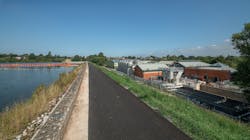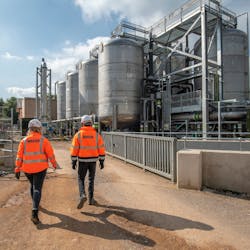Wessex Water continues construction of Durleigh plant
Wessex Water recently announced that its £50 million project to upgrade Durleigh Water Treatment Centre in Somerset is progressing on program and within budget, despite some unique challenges posed by the Covid-19 pandemic.
Work at the site near Bridgwater started in 2019. It is the largest single-value scheme delivered by Wessex Water’s Engineering and Sustainable Delivery (ESD) department and forms part of the company’s long-term water supply strategy for Somerset.
Drawing from Durleigh Reservoir to the west, the old centre had come to the end of its operational life and extensive reconstruction was needed to maintain delivery of the highest quality drinking water to a population of 44,500.
The project was a finalist in Bentley Systems’s Year in Infrastructure 2020 Awards program. Demolition was complete and all was going according to plan when Covid rose in March 2020, forcing a change in working practices.
“It was far from ideal, and the pandemic has certainly impacted the project’s opportunity for early completion, but I have to pay tribute to the whole team for the way they have adapted and taken it all in their stride.”
The Project Continues
Durleigh is the first major project to be delivered by Wessex Water ESD, utilizing Building Information Modelling (BIM), with AECOM appointed to deliver the digital design using the Autodesk suite of products and Bentley’s ProjectWise software for the common data environment.
Much of the old center has been demolished and outdated equipment decommissioned, but Wessex Water has been able to repurpose or recycle around 30 percent of structures to ensure value for money. Refurbishment of the existing chemical treatment building is ongoing and forms a crucial phase of the project.
The building has now been restructured to house refurbished contact tanks, refurbished chemical storage tanks and bunds, installation of new chlorine and sulfur dioxide storage and dosing, high lift network distribution tanks, UV treatment, additional chemical storage and dosing, emergency generation along with a new power distribution board, several motor control centres, programable logic controllers, a secondary SCADA system and full building ventilation systems.
A secure compound has been constructed adjacent to the building, housing a new transformer switchgear and ring main unit required as part of an upgrade to the 11Kv power supply.
Existing wastewater tanks and existing workshop to the west of the site have also been retained, reconfigured and repurposed to meet the new process design requirements.
New Builds
Granular activated carbon (GAC) construction, installation and dry tests are now complete with pre-use safety inspections also complete and ready for process commissioning.
Construction of a new reinforced concrete slab over the existing reconfigured wastewater tanks is complete and forms the base for the newly installed sludge thickening Lamellas.
Construction of the new main treatment building (MTB) has included piled foundations split level reinforced concrete bases and a security-cladded steel frame building. Installation of process tanks is complete with mechanical, electrical, controls and automation work nearing completion and early mechanical / electrical dry tests started.
The MTB also houses a new admin block containing the water treatment center reception area, welfare facilities, motor control center, programable logic controller, laboratory, main control room and the primary SCADA system.
The new low lift pump area including backwash, forward flow and waste transfer pump stations, motor control center, programable logic controller, manganese pressure filters and associated interconnecting pipework and cabling is also nearing completion.
Wessex Water ESD has also completed the build of two new wetland habitats at the head of Durleigh Reservoir. These are designed to filter silt and coarse sediment, helping to improve the raw water quality entering the reservoir and benefiting wildlife such as amphibians and dragonflies.
The wetlands project has been aided by Wessex Water’s catchment delivery team, who work with local farmers to reduce pesticides and silt entering the watercourse.
The Next Phase
Completion of mechanical and electrical installations, dry testing, further sectional pre-use safety inspections, software site acceptance tests, process commissioning, construction of roads, paths and final planting and reinstatements.
“Some early completion targets had to be adjusted but we’re currently planning to have water back in supply next year," said Coates. “Given such a complex and large-scale project, Covid could easily have delayed us by six months or more. Everyone in our ESD team, AECOM and our supply chain deserves enormous credit.

